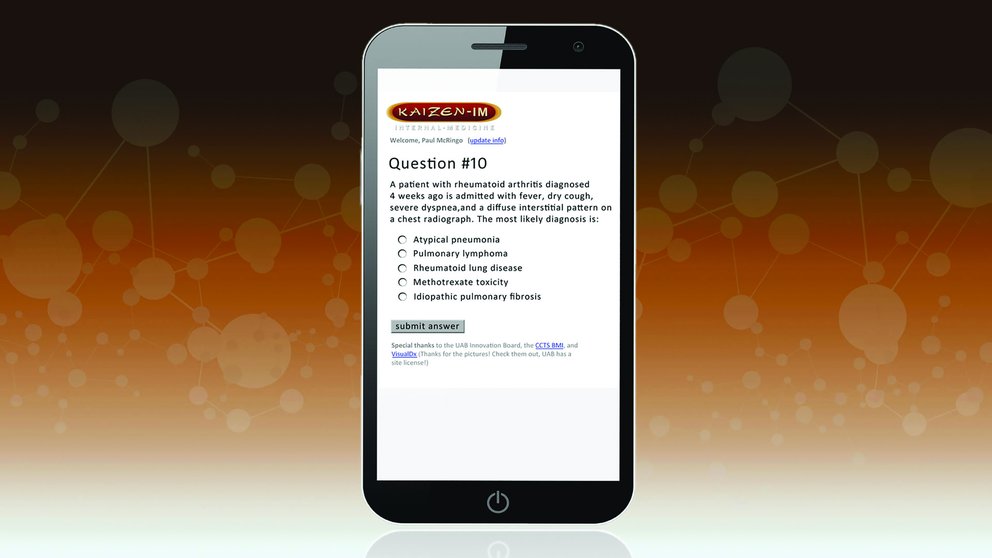
Editor’s Note: Throughout 2016, AAMCNews will explore how medical schools and teaching hospitals are educating the next generation of physicians in an environment of discovery and innovation.
Do games have a legitimate place in medical education?
Researchers at Stanford University School of Medicine have assessed several years of experience with a game called Septris, which is modeled after the video game Tetris. Introduced in 2011, Septris helps medical trainees learn to recognize and treat sepsis, a potentially life-threatening complication of infection.
In research published last year in Academic Medicine, Kambria H. Evans, MEd, MA, and colleagues found that Septris helped to significantly improve users’ knowledge in recognizing and managing the condition.
According to a 2015 Pew Research Center survey, 49 percent of American adults play video games. Many students come to medical school with an affinity for games, Evans said, adding that there is room to further develop gaming in medical education. “There is such an opportunity here because the interest is already there,” said Evans, director of education and quality improvement at Stanford.
Students like games
Looking at the bigger picture, the Stanford researchers found that medical trainees respond well to game playing as a learning tool. When asked in 2015 to rank modes of learning such as lectures, small-group study, and simulations, 21 percent of Stanford’s incoming clerkship students put gaming in their top three favorite ways to learn, as did 43 percent of incoming medical interns.
At the University of Alabama at Birmingham (UAB) School of Medicine, resident duty hour restrictions helped spark game development. James H. Willig, MD, MSPH, an associate professor, was concerned that the new Accreditation Council for Graduate Medical Education rules restricting the number of hours residents can be on duty would reduce the time for learning. To help fill that gap—and tap millennials’ interest in games—Willig and colleagues developed Kaizen, an online quiz game that launched in 2013.
Kaizen, named after the Japanese term for “continuous improvement,” asks multiple choice questions about clinical knowledge. Students compete to answer questions that are designed to be responded to quickly—during an elevator ride, for example. “The idea is that by the time I get off the elevator, I have read a couple of sentences regarding the question’s explanation, and I have a piece of knowledge that I can go apply,” Willig said. Originally designed for residents, the Kaizen platform has been adapted by many programs in UAB’s medical and nursing schools.
There was an 11.9 percent increase in correct answers among students who answered a Kaizen question incorrectly on the first try, according to research Willig and colleagues recently published in the Postgraduate Medical Journal. “This finding suggests enhanced knowledge retention at three and six months” for material shared through the game, Willig said. Moreover, the researchers noted, Kaizen kept trainees learning outside regular work and training hours.
“For me, and I assume for a lot of other MDs, it’s fun to be competitive,” said William Benton, MD, a third-year resident at UAB. “Kaizen takes learning that might tend to be boring and turns it into a team activity. Part of why I play is that I’m trying to do my best and beat other people, which makes it fun.”
Games and learning theory
B. Price Kerfoot, MD, EdM, an associate professor of surgery at Harvard Medical School, has conducted more than 20 large randomized controlled trials assessing the efficacy of online “spaced education” methodology—the process of repeatedly delivering information in chunks over time, in a test format, to improve knowledge retention and clinical practice patterns. That style of learning lends itself well to games. In a 2014 article in Circulation Cardiovascular Quality and Outcomes, Kerfoot and colleagues concluded that “educational games may be effective tools to engage health professionals, boost learning, optimize practice patterns, and improve patient outcomes.”
Another investigator, Adam Gazzaley, MD, PhD, is a professor of neurology, physiology, and psychiatry at the University of California, San Francisco, School of Medicine, who studies gaming in the context of cognitive neuroscience. Games embody a closed-loop system, he said, in which the game constantly reads a gamer’s performance and tailors itself to the user’s abilities. Gazzaley believes games are a powerful way to deliver personalized education, which he said is especially valuable for medical students and residents “who are searching for truly optimal performance.” For medical schools, he said, “there is great potential to use game mechanics, coupled with sound scientific design, to usher in a whole new generation of learning tools.”
“There is great potential to use game mechanics, coupled with sound scientific design, to usher in a whole new generation of learning tools.”
Adam Gazzaley, MD, PhD, University of California, San Francisco, School of Medicine
Many investigators say that further research is necessary to document gaming’s efficacy as a pedagogical tool in medical education. There are other challenges to incorporating gaming into medical education. The tradition of games being used for amusement casts a cloud over the use of games for learning. And games can be expensive to develop. Stanford, for example, spent some $50,000 in developing Septris.
Even as research continues, however, investigators are convinced there is promise in using games in medical education.
“Based on our data, well-designed games can fit very well within medical education,” Kerfoot said. “There is tremendous potential in games and game mechanics to improve educational outcomes, in terms of improving clinicians’ knowledge and their practice patterns, as well as the health outcomes of their patients. Support from medical leaders to promote investigation in this area would be a tremendous asset for the development of the field.”
This article originally appeared in print in the May/June 2016 issue of the AAMC Reporter.